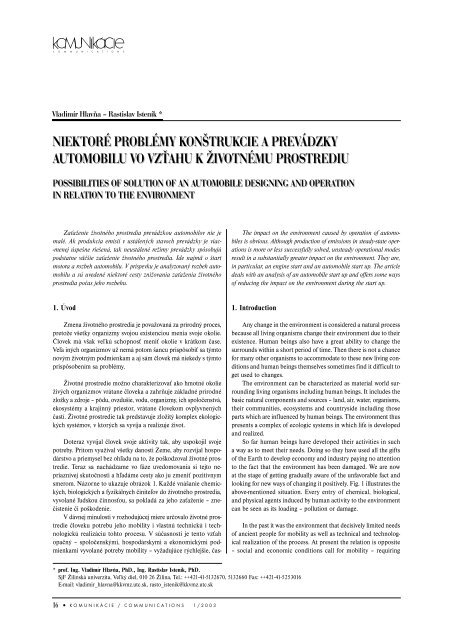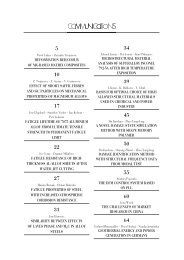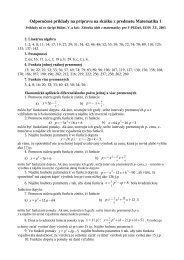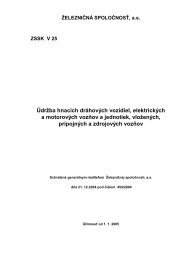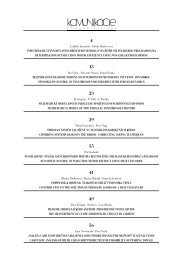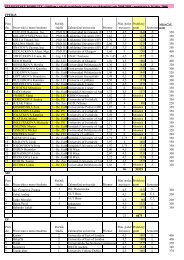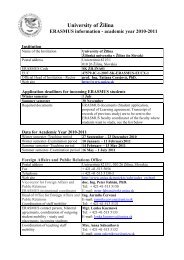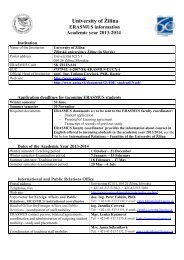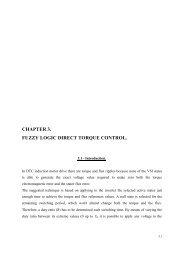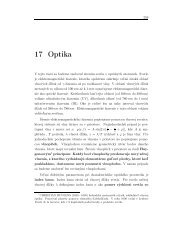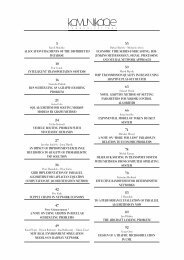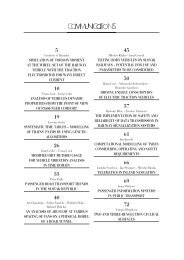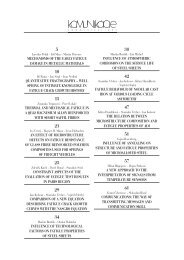posudzovanie vplyvu automobilovej dopravy na ... - Žilinská univerzita
posudzovanie vplyvu automobilovej dopravy na ... - Žilinská univerzita
posudzovanie vplyvu automobilovej dopravy na ... - Žilinská univerzita
You also want an ePaper? Increase the reach of your titles
YUMPU automatically turns print PDFs into web optimized ePapers that Google loves.
C O M M U N I C A T I O N S<br />
I S<br />
Vladimír Hlavňa – Rastislav Isteník *<br />
NIEKTORÉ PROBLÉMY KONŠTRUKCIE A PREVÁDZKY<br />
AUTOMOBILU VO VZŤAHU K ŽIVOTNÉMU PROSTREDIU<br />
POSSIBILITIES OF SOLUTION OF AN AUTOMOBILE DESIGNING AND OPERATION<br />
IN RELATION TO THE ENVIRONMENT<br />
Zaťaženie životného prostredia prevádzkou automobilov nie je<br />
malé. Ak produkcia emisií v ustálených stavoch prevádzky je viac-<br />
-menej úspešne riešená, tak neustálené režimy prevádzky spôsobujú<br />
podstatne väčšie zaťaženie životného prostredia. Ide <strong>na</strong>jmä o štart<br />
motora a rozbeh automobilu. V príspevku je a<strong>na</strong>lyzovaný rozbeh automobilu<br />
a sú uvedené niektoré cesty znižovania zaťaženia životného<br />
prostredia počas jeho rozbehu.<br />
The impact on the environment caused by operation of automobiles<br />
is obvious. Although production of emissions in steady-state operations<br />
is more or less successfully solved, unsteady operatio<strong>na</strong>l modes<br />
result in a substantially greater impact on the environment. They are,<br />
in particular, an engine start and an automobile start up. The article<br />
deals with an a<strong>na</strong>lysis of an automobile start up and offers some ways<br />
of reducing the impact on the environment during the start up.<br />
1. Úvod<br />
Zme<strong>na</strong> životného prostredia je považovaná za prírodný proces,<br />
pretože všetky organizmy svojou existenciou menia svoje okolie.<br />
Človek má však veľkú schopnosť meniť okolie v krátkom čase.<br />
Veľa iných organizmov už nemá potom šancu prispôsobiť sa týmto<br />
novým životným podmienkam a aj sám človek má niekedy s týmto<br />
prispôsobením sa problémy.<br />
Životné prostredie možno charakterizovať ako hmotné okolie<br />
živých organizmov vrátane človeka a zahrňuje základné prírodné<br />
zložky a zdroje – pôdu, ovzdušie, vodu, organizmy, ich spoločenstvá,<br />
ekosystémy a krajinný priestor, vrátane človekom ovplyvnených<br />
častí. Životné prostredie tak predstavuje zložitý komplex ekologických<br />
systémov, v ktorých sa vyvíja a realizuje život.<br />
Doteraz vyvíjal človek svoje aktivity tak, aby uspokojil svoje<br />
potreby. Pritom využíval všetky danosti Zeme, aby rozvíjal hospodárstvo<br />
a priemysel bez ohľadu <strong>na</strong> to, že poškodzoval životné prostredie.<br />
Teraz sa <strong>na</strong>chádzame vo fáze uvedomovania si tejto nepriaznivej<br />
skutočnosti a hľadáme cesty ako ju zmeniť pozitívnym<br />
smerom. Názorne to ukazuje obrázok 1. Každé vnášanie chemických,<br />
biologických a fyzikálnych činiteľov do životného prostredia,<br />
vyvolané ľudskou činnosťou, sa pokladá za jeho zaťaženie – znečistenie<br />
či poškodenie.<br />
V dávnej minulosti v rozhodujúcej miere určovalo životné prostredie<br />
človeku potrebu jeho mobility i vlastnú technickú i technologickú<br />
realizáciu tohto procesu. V súčasnosti je tento vzťah<br />
opačný – spoločenskými, hospodárskymi a ekonomickými podmienkami<br />
vyvolané potreby mobility – vyžadujúce rýchlejšie, čas-<br />
1. Introduction<br />
Any change in the environment is considered a <strong>na</strong>tural process<br />
because all living organisms change their environment due to their<br />
existence. Human beings also have a great ability to change the<br />
surrounds within a short period of time. Then there is not a chance<br />
for many other organisms to accommodate to these new living conditions<br />
and human beings themselves sometimes find it difficult to<br />
get used to changes.<br />
The environment can be characterized as material world surrounding<br />
living organisms including human beings. It includes the<br />
basic <strong>na</strong>tural components and sources – land, air, water, organisms,<br />
their communities, ecosystems and countryside including those<br />
parts which are influenced by human beings. The environment thus<br />
presents a complex of ecologic systems in which life is developed<br />
and realized.<br />
So far human beings have developed their activities in such<br />
a way as to meet their needs. Doing so they have used all the gifts<br />
of the Earth to develop economy and industry paying no attention<br />
to the fact that the environment has been damaged. We are now<br />
at the stage of getting gradually aware of the unfavorable fact and<br />
looking for new ways of changing it positively. Fig. 1 illustrates the<br />
above-mentioned situation. Every entry of chemical, biological,<br />
and physical agents induced by human activity to the environment<br />
can be seen as its loading – pollution or damage.<br />
In the past it was the environment that decisively limited needs<br />
of ancient people for mobility as well as technical and technological<br />
realization of the process. At present the relation is opposite<br />
– social and economic conditions call for mobility – requiring<br />
* prof. Ing. Vladimír Hlavňa, PhD., Ing. Rastislav Isteník, PhD.<br />
SjF Žilinská <strong>univerzita</strong>, Veľký diel, 010 26 Žili<strong>na</strong>, Tel.: ++421-41-5132670, 5132660 Fax: ++421-41-5253016<br />
E-mail: vladimir_hlav<strong>na</strong>@kkvmz.utc.sk, rasto_istenik@kkvmz.utc.sk<br />
16 ● KOMUNIKÁCIE / COMMUNICATIONS 1/2003


